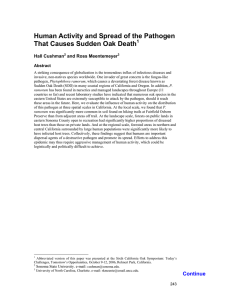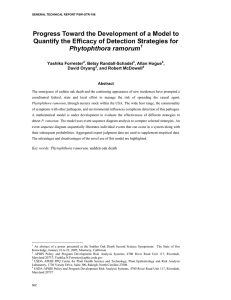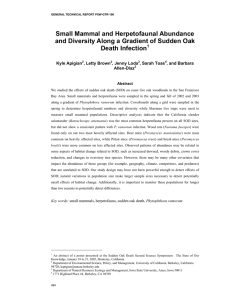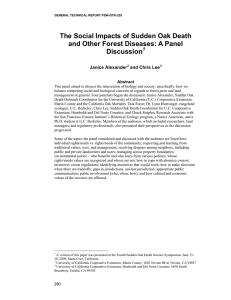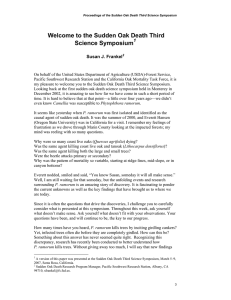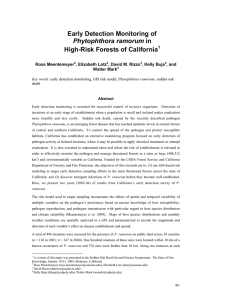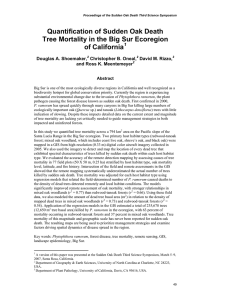History and Background of the California Oak Mortality Task Force (COMTF)
advertisement
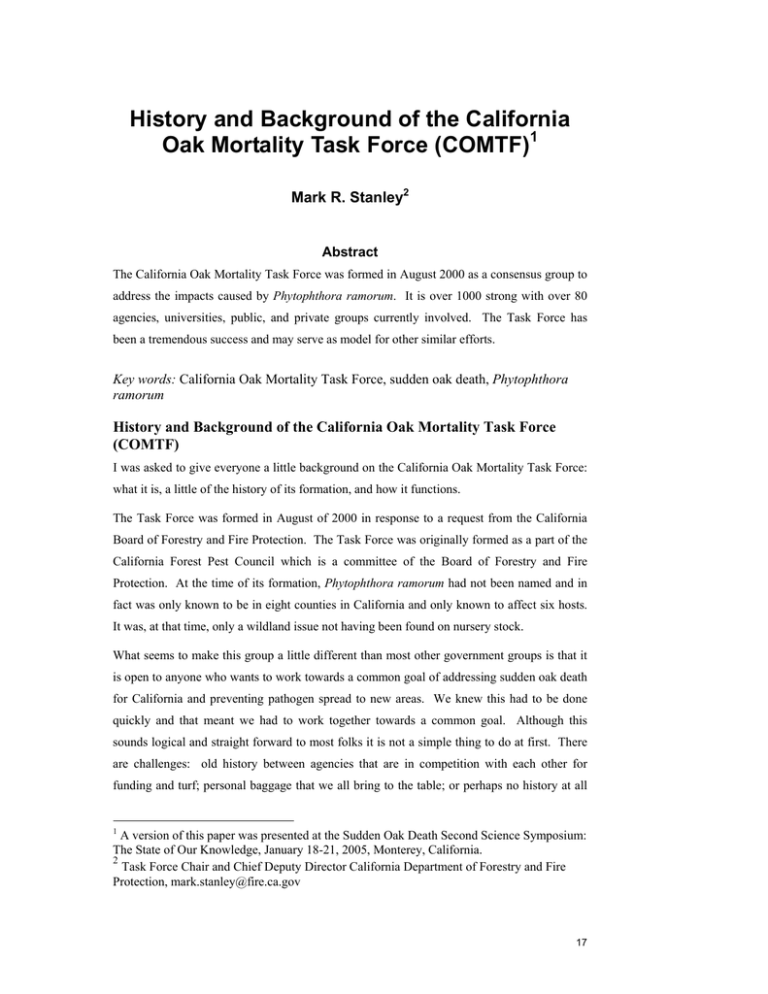
History and Background of the California Oak Mortality Task Force (COMTF)1 Mark R. Stanley2 Abstract The California Oak Mortality Task Force was formed in August 2000 as a consensus group to address the impacts caused by Phytophthora ramorum. It is over 1000 strong with over 80 agencies, universities, public, and private groups currently involved. The Task Force has been a tremendous success and may serve as model for other similar efforts. Key words: California Oak Mortality Task Force, sudden oak death, Phytophthora ramorum History and Background of the California Oak Mortality Task Force (COMTF) I was asked to give everyone a little background on the California Oak Mortality Task Force: what it is, a little of the history of its formation, and how it functions. The Task Force was formed in August of 2000 in response to a request from the California Board of Forestry and Fire Protection. The Task Force was originally formed as a part of the California Forest Pest Council which is a committee of the Board of Forestry and Fire Protection. At the time of its formation, Phytophthora ramorum had not been named and in fact was only known to be in eight counties in California and only known to affect six hosts. It was, at that time, only a wildland issue not having been found on nursery stock. What seems to make this group a little different than most other government groups is that it is open to anyone who wants to work towards a common goal of addressing sudden oak death for California and preventing pathogen spread to new areas. We knew this had to be done quickly and that meant we had to work together towards a common goal. Although this sounds logical and straight forward to most folks it is not a simple thing to do at first. There are challenges: old history between agencies that are in competition with each other for funding and turf; personal baggage that we all bring to the table; or perhaps no history at all 1 A version of this paper was presented at the Sudden Oak Death Second Science Symposium: The State of Our Knowledge, January 18-21, 2005, Monterey, California. 2 Task Force Chair and Chief Deputy Director California Department of Forestry and Fire Protection, mark.stanley@fire.ca.gov 17 GENERAL TECHNICAL REPORT PSW-GTR-196 and therefore no established level of trust. You also have to have a leader that is as much a facilitator as a leader. Someone who can organize, lead, and motivate, without people feeling that they are losing their or their agencies or organization’s power and identity. We were fortunate to have Susan Frankel be that leader. We were also fortunate to have people that saw that working together was more important than building their egos or their organization. We would have a common voice for funding that would benefit the State not necessarily any one agency or group. We wanted to, and did, utilize the strengths of each organization and individual to achieve our common goals. We worked entirely on consensus. We worked on our goals and a plan of action until we reached agreement by all members of the Task Force. We had some basic agreements and those were that information and training would be science based. We agreed that we had common goals of education, outreach, coordination and sharing information and resources. We would have a common voice for information that we communicated to the public and other professionals both inside and outside of the Task Force. To this end we had a public information officer for the task force that either spoke for, or worked with the various information officers for different agencies. This can be a very sensitive area but it can and did bring tremendous credibility to the group and to the individual agencies. We also agreed to support each other’s efforts as it related to P ramorum. Having a small staff is critical for coordination and communications inside and outside of the group. Everyone on the Task Force already had a full time job and the Task Force needed a few individuals that could help not only coordinate the group, but provide quick response to the needs of the public, partners, and communities that were impacted by the disease. As a task force we wanted to lead the effort, not follow the parade. This required everyone to communicate with everyone else and so we developed a website to help with that communication. We continue to provide education and training on the pathogen, its biology and possible management, and provide publications in several languages and for scores of special user groups from arborists, to foresters, nurseries to tribal groups, recreation users to mushroom collectors. We have done scores of training sessions at very low or no cost to the participants to help get the information into the hands of the businesses, organizations, and individuals impacted by this pathogen. We have not only provided training and delivered presentations throughout the State and the nation, but we have also conducted training on how to form and operate a group like the Task Force that has proven to be successful and beneficial. One of the reasons for our success with our various activities and success at obtaining funding to help these efforts is the press and other media folks. Contrary to popular beliefs the press 18 Proceedings of the sudden oak death second science symposium: the state of our knowledge can be your friend. This takes care and nurturing to develop a good and honest working relationship as well as a trust level that you will actually work with the media. Last and certainly not least I have to thank and commend the members of the Task Force. Everyone was fully employed and busy before this started. It is only through all the extra work, effort and commitment to work together to try and address this problem have we had success. There have been many long nights, endless conference calls and meetings, and people stepping up to do extra work. The Task Force has been fortunate to hire a few staff people to do all the coordination, website development and maintenance, and to work with the press. Without the professional work and personal commitment of these people we would not be here today. It is because of the people involved in the Task Force that we have had success in working toward our common goals. And as always for the latest information on Phytophthora ramorum or sudden oak death go to www.suddenoakdeath.org. 19
